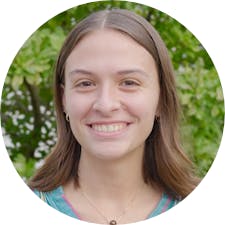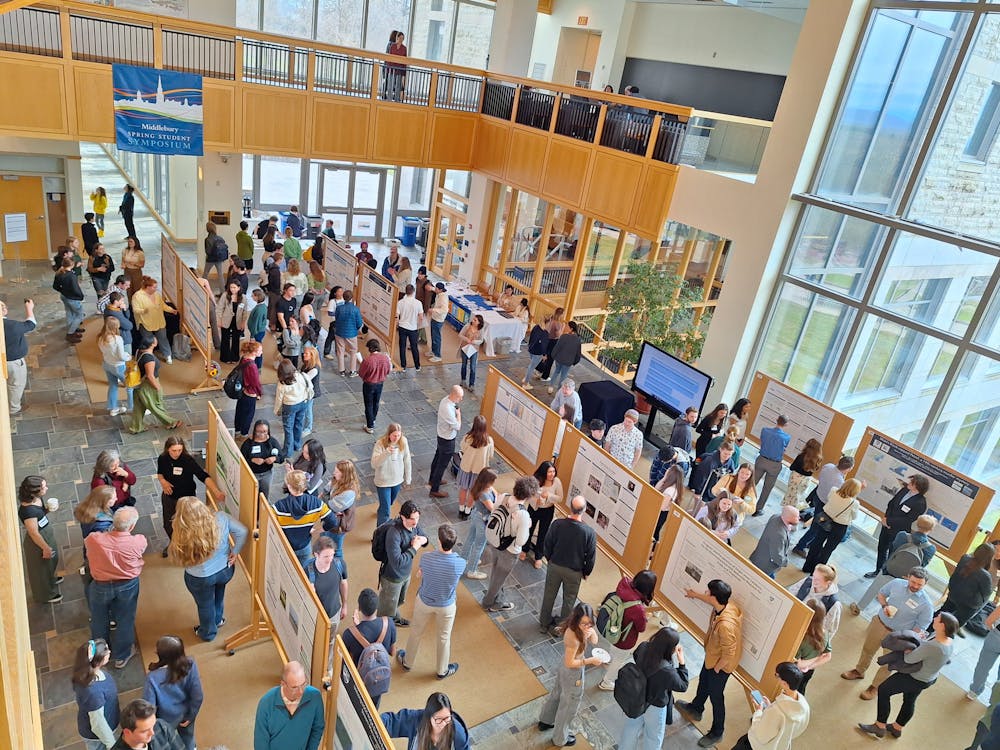With 245 student presenters representing 35 departments ranging from Biology to History to Film and Media Culture, Middlebury hosted its 17th annual Student Spring Symposium last Friday, April 19.
But the 109 oral presentations and 56 poster presentations were not all that took off on Friday. A team of students and professors from the Physics department also launched Middlebury’s first ever high-altitude balloon to a captivated audience of over one hundred people inside and outside BiHall, providing a real-time insight into the research of the Physics department.
Amy Morsman, professor of History and director of the Center for Teaching Learning and Research (CTLR), co-chaired the Symposium Committee for the first time this year alongside Professor of Anthropology Michael Sheridan, who also co-chaired the committee for the first time but has served on the organization committee for about 10 years.
The symposium was created in 2007 by then-Associate Dean of Student Affairs Karen Guttentag and Dean of Undergraduate Research Pat Manley. The idea behind the symposium has always been to showcase student research at Middlebury, according to Sheridan.
“Part of the inspiration was that few students have the opportunity to go to a professional academic conference,” Sheridan wrote in an email to The Campus. “It’s one of the best things our academic community does.”
The symposium had roughly 60 participants in its first year and has since grown to have 225–245 participants each year, something President Laurie Patton praised during her opening remarks in BiHall’s Great Hall on Friday morning. She also thanked the faculty, moderators, staff and students for presenting their work to the entire community.
“Students share with each other their intellectual passions and discover what inspires their fellow classmates. We celebrate this opportunity every year because we get to learn from an incredible array of research and creative work,” Patton said.
One such presenter was Nick Dahlen ’24, who gave an oral presentation entitled “Contemporary Arabic Poetry: Challenges in Translation.” Dahlen’s presentation highlighted the work he has done for his senior project in the Arabic Department with Surdna Professor of Linguistics and Arabic Usama Soltan. He translated a selection of poetry from a diwan, the Arabic term for a collection of poetry, entitled “Shuhuud Gaza,” or “Witnesses of Gaza,” by Jordanian poet Abdullah Amiin Abu Shmais.
Dahlen interviewed the poet for a literature class he was taking while studying abroad in Jordan last fall, and focused his presentation on the difficulties of translating the work.
“There was certainly some ambiguity in his poetry, and I enjoyed bringing my translations to my advisor and working through questions and challenges in the translation process,” he wrote in a message to The Campus.
He added that he enjoyed the opportunity to share this work with his friends and peers.
Earlier in the day during the first poster session of the symposium, Natalie Eddy ’24 presented her senior economics thesis, “Climate Change Beliefs and Fertility Expectations.” Together with her advisers, Eddy is running a survey on the effect of sharing information about climate change on the number of children respondents plan to have.
“I tried to present my information like I was telling a story, logically moving from the motivation for the work into how we are exploring our research question and then into the results we have already found and what we plan to find in the future,” Eddy wrote in a message to The Campus.
Planning these and hundreds of other presentations at the symposium involves a lot of moving pieces, according to Morsman. She credited Jill Strube and Colleen Norden in the CTLR and Cathy Ekstrom in BiHall, among others, who make the symposium run smoothly each year.
Ekstrom, program coordinator for sciences and technical support in BiHall, has been involved with the symposium since it began 17 years ago. She is responsible for the posters, while Norden coordinates the timing of presentations.
“It is probably the busiest week of my year,” Ekstrom said in an interview with The Campus, though she acknowledged that this is not entirely due to the symposium, as it is also a very busy time of the semester.
“Part of our goal is to make it as diverse as possible,” Ekstrom said. “We try to not put all of humanities or biology together.”
The organizers hoped to spark students’ interest by grouping diverse topics of talks and including posters from a range of subjects in the same poster session, encouraging them to walk around and see a diverse array of projects.
Even students who were busy presenting that day took the opportunity to learn from their peers and see what their friends were up to.
“I spent the morning bouncing from one presentation to another, learning about indigenous water rights, magnets and machine learning, economics in the airline industry, and the significance of bread in Egypt,” Dahlen wrote. “Being able to learn about so many new topics from other students is definitely my favorite part of [the] symposium.”
Eddy agreed, stating that her favorite part of the symposium was learning about all of the interesting work her friends were doing.
“I hear about it on a day to day basis but especially with science research I get a little lost in the details, so seeing the information presented really ties everything together,” she wrote.
In addition to poster and oral presentations, this year’s symposium featured a high altitude balloon launch for the first time at Middlebury, according to Ellie Suit ’24, who helped organize the launch. In such a launch, a balloon is filled up with hydrogen or helium — in this case it was hydrogen — and released to study phenomena that occur at high altitudes, Suit described.
“These balloons are designed to go up to the stratosphere and our type of balloon usually goes between 85,000 to 115,000 feet. Our balloon got up to around 94,000 feet and its maximum ascent rate was 25.9 mph and maximum descent rate was 121 mph,” Suit wrote in an email to The Campus.
The physics department will use the information from the launch to analyze the data from muons, which are a heavier version of atoms of sorts. They hope that the data will help them analyze the relationship between altitude and number of muons to test Einstein’s theory of special relativity, which posits that time slows down as objects approach the speed of light.
The launch was in collaboration with Georgia State University and the company Launch With Us. Physics Professor Noah Graham met with John Garesché, the chief ballooner of company Launch With Us, who is also the parent of a Middlebury student, in the fall of 2023 to plan the launch. The balloon involved student participation at every stage of the process, making it a perfect fit for the symposium.
“People got the chance to be involved in a variety of tasks including designing experiments, setting up the balloon launch both the day before and the day of, and recovering the balloon after it landed,” Suit wrote.
Planning the launch involved a lot of logistics, including timing and building muon detectors. Suit connected with a group at Georgia State University, who teamed up with Middlebury by lending their detectors for the launch.
Where the balloon ends up is largely influenced by weather conditions. At one point it was projected to land just over the Canadian border, but in the end it landed in Chelsea, Vt., about a 50 minute drive from campus.
“The balloon was stuck in a tree when the recovery team got there, but it was low enough that they could reach for it to get it down,” Suit explained, adding that the balloon had popped as intended and was disposed of after the launch.
“It was really exciting to be a part of and spring symposium was a perfect time to do it so that we can share this experience with the student body,” Suit wrote.
Whether they stood outside BiHall, craning their necks to see the balloon launch, or presented data on topics ranging from droughts in Colorado to teen pregnancy, it was the students who formed the core of the spring symposium. Even though many seniors were presenting their theses, the symposium is open to all students who have research to share. “We want first-years, sophomores, and juniors to get involved!” Sheridan wrote.
Morsman also appreciated seeing first-time student presenters, especially underclassmen.
“The look on their face when they really get into their presentation and when the clapping begins is priceless,” she wrote.
Editor’s note: Managing Editor Ryan McElroy ’25 contributed reporting to this article.

Julia Pepper '24 (she/her) is the Senior Local Editor.
She previously served as a Local Editor. She is a Psychology major and French minor. This past spring she studied in Paris. She spent the summer interning at home in New York City, putting her journalistic cold calling skills to use at her internship doing outreach with senior citizens. In her free time she enjoys reading and petting cats.




